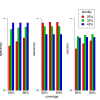Ultra-fast sequence clustering from similarity networks with SiLiX
- PMID: 21513511
- PMCID: PMC3095554
- DOI: 10.1186/1471-2105-12-116
Ultra-fast sequence clustering from similarity networks with SiLiX
Abstract
Background: The number of gene sequences that are available for comparative genomics approaches is increasing extremely quickly. A current challenge is to be able to handle this huge amount of sequences in order to build families of homologous sequences in a reasonable time.
Results: We present the software package SiLiX that implements a novel method which reconsiders single linkage clustering with a graph theoretical approach. A parallel version of the algorithms is also presented. As a demonstration of the ability of our software, we clustered more than 3 millions sequences from about 2 billion BLAST hits in 7 minutes, with a high clustering quality, both in terms of sensitivity and specificity.
Conclusions: Comparing state-of-the-art software, SiLiX presents the best up-to-date capabilities to face the problem of clustering large collections of sequences. SiLiX is freely available at http://lbbe.univ-lyon1.fr/SiLiX.
Figures




References
Publication types
MeSH terms
LinkOut - more resources
Full Text Sources
Other Literature Sources
Research Materials

